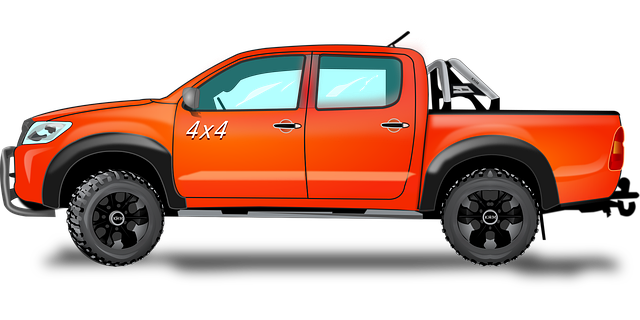Shackles, like chain, wire rope, and bolt types, are essential mechanical fasteners used globally across industries for securing heavy loads, with RGV (radio-controlled guided vehicle) wheels and tires playing a significant role in their functionality. These wheels enhance mobility, control, and stability in harsh conditions, improving performance and reducing wear on equipment. Shackles' versatility is evident in automotive, construction, maritime, and aviation sectors, where they secure cargo, lift heavy equipment, and fasten ship rigging. Choosing robust shackles with forged steel construction, compatible fit, and proper installation for off-road use ensures optimal performance during rugged terrain adventures. Regular maintenance, including inspections, lubrication, and tightening, is vital for prolonging shackle lifespan. Future advancements in materials science and smart technology integration will revolutionize shackle design, optimizing load monitoring, control, efficiency, durability, and environmental sustainability, especially in trucking and logistics with the increasing adoption of RGV wheels and tires.
Shackles, an essential component in various industries, are versatile hardware designed to secure, connect, or suspend objects. This article delves into the multifaceted world of shackles, exploring their definitions, types, and applications across diverse sectors. We highlight the critical role of RGV wheels and tires in shackle systems, offering insights on selection, installation, maintenance, and safety. Additionally, we preview future trends in shackle technology, including advancements in materials and design for enhanced performance and reliability.
- Understanding Shackles: Definition and Types
- The Role of RGV Wheels and Tires in Shackle Systems
- Common Applications of Shackles in Various Industries
- Selection and Installation Considerations for Optimal Performance
- Maintenance and Safety Protocols for Prolonged Shackle Lifespan
- Future Trends and Innovations in Shackle Technology
Understanding Shackles: Definition and Types

Shackles, in their most basic form, are mechanical devices used for fastening or connecting two or more objects together. They come in various types, each designed for specific purposes, such as securing wheels and tires on vehicles, known by terms like RGV wheels and tires. These include chain shackles, wire rope shackles, and bolt shackles, among others.
Chain shackles, for instance, are typically used in heavy-duty applications due to their strength and flexibility. Wire rope shackles, on the other hand, offer exceptional resistance to breaking and are commonly employed in industrial settings. Bolt shackles, with their simple yet effective design, are versatile and can be found in everything from construction equipment to everyday items like bicycle locks. Understanding these variations is key to selecting the right shackle for any given task, ensuring both functionality and safety.
The Role of RGV Wheels and Tires in Shackle Systems

In shackle systems, RGV (radio-controlled guided vehicle) wheels and tires play a pivotal role by enhancing mobility and control. These specialized components are designed to withstand harsh conditions, ensuring efficient operation in diverse terrains. The advanced technology integrated into RGV wheels enables precise navigation, allowing for seamless movement of heavy loads or complex machinery, which is crucial in various industries like construction, mining, and logistics.
The versatility of rgv wheels and tires lies in their adaptability to different shackle configurations. They offer superior traction and stability, especially in challenging environments. This capability not only improves overall performance but also extends the lifespan of the shackle system by reducing wear and tear. Furthermore, regular upgrades and maintenance of these components contribute significantly to maintaining optimal efficiency in shackle operations.
Common Applications of Shackles in Various Industries

Shackles play a pivotal role in various industries due to their versatility and robust design. In the automotive sector, particularly within RGV wheels and tires, shackles are essential for securing heavy loads onto trailers or transport vehicles. They ensure stability during transit, preventing cargo shift that could lead to accidents.
Beyond the automotive industry, shackles find applications in construction, maritime, and even aviation. Construction sites rely on them for lifting and moving heavy equipment while sailors use shackles for securing ropes and rigging on board ships. In aviation, shackles are utilized for securing aircraft components during maintenance and transport, ensuring safety and reliability.
Selection and Installation Considerations for Optimal Performance

When selecting shackles, it’s crucial to consider factors that ensure optimal performance and safety. For rugged terrain and off-road adventures, investing in high-quality shackles designed for strength and durability is essential. Look for options featuring robust construction, such as those made from forged steel, which offer superior grip and stability compared to their weaker counterparts. Additionally, the compatibility with your vehicle’s existing suspension system is vital; ensuring a seamless fit without compromising structural integrity.
Installation plays a significant role in achieving peak performance. Properly securing shackles is paramount to prevent accidental detachment during intense driving conditions. Utilize RGV wheels and tires that are specifically designed for off-road use, as they offer enhanced traction and stability on uneven surfaces. Follow manufacturer guidelines carefully during installation to avoid damage or compromised effectiveness. Regular maintenance checks, including inspecting bolts and pins for signs of wear, will further guarantee optimal shackle performance throughout your adventurous journeys.
Maintenance and Safety Protocols for Prolonged Shackle Lifespan

Regular maintenance is key to ensuring shackles, especially those used with RGV wheels and tires, have a long and efficient lifespan. It involves periodic inspections to identify any signs of wear, tear or damage. Lubrication is also essential, as it reduces friction points and prevents rust accumulation, which can compromise the integrity of the shackle. Additionally, tightening connections regularly ensures optimal performance and safety during operation.
Safety protocols should be strictly followed to prevent accidents and extend shackle life. This includes using appropriate tools for adjustments and inspections, wearing protective gear when necessary, and adhering to weight capacity limits. Regular maintenance and strict adherence to safety measures will help preserve the condition of shackles, ensuring they remain reliable components in RGV wheel and tire systems.
Future Trends and Innovations in Shackle Technology

The future of shackles is poised for significant advancements, driven by innovations in materials science and engineering. One prominent trend is the integration of smart technology, enabling real-time monitoring and control of load distribution. This is particularly relevant for industries like trucking and logistics where efficient tire management is crucial, especially with the growing adoption of RGV (Reach Stacker Vehicle) wheels and tires. Advanced sensors and connected systems can optimize shackle performance, enhancing safety and reducing downtime.
Additionally, lightweight materials such as high-strength alloys and composite structures are expected to gain traction, improving overall efficiency and fuel economy. These innovations will be pivotal in addressing the global demand for sustainable transportation solutions. The combination of smart technology and lightweight materials promises a new era of shackle design, ensuring better control, enhanced durability, and reduced environmental impact.
Shackles, an essential component in various industries, continue to evolve with technological advancements. RGV (Rigid GVW) wheels and tires play a pivotal role in shackle systems, enhancing performance and durability. As we look ahead, future trends promise innovative materials, improved designs, and enhanced safety features for shackles. Regular maintenance and the consideration of optimal selection and installation are crucial for maximizing their lifespan. Understanding these aspects ensures that shackles remain reliable, efficient, and safe across diverse applications, from construction to automotive.
